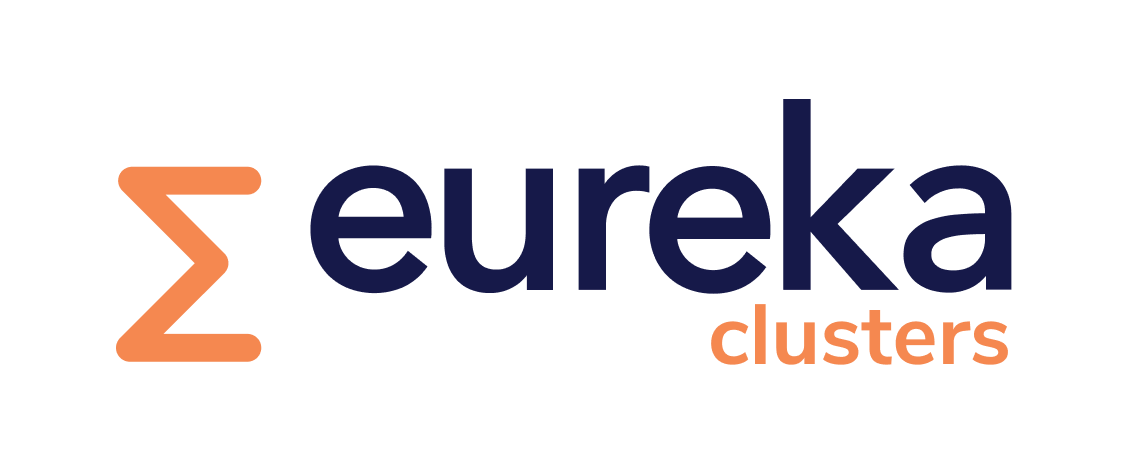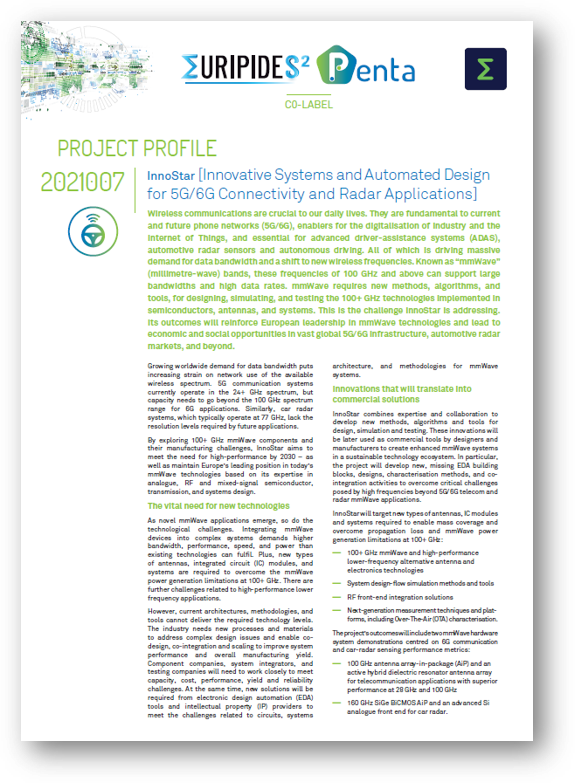Project status :
Running
Project website :
https://project-innostar.com/
Key application areas
 Digital society
Digital society  Mobility
Mobility Essential capabilities
 Components, Modules and Systems Integration
Components, Modules and Systems Integration  Architecture and Design: Methods and Tools
Architecture and Design: Methods and Tools  Connectivity
Connectivity  Process Technologies, Equipment, Materials and Manufacturing
Process Technologies, Equipment, Materials and Manufacturing
PARTNER
Bluetest AB / CEMWorks Inc / CHALMERS TEKNISKA HOEGSKOLA / Eindhoven University of Technology / Ericsson AB / Fraunhofer ENAS / Fraunhofer IIS/EAS / Gotmic AB / IMST GmbH / Infineon Technologies AG / MunEDA GmbH / NXP Semiconductors Netherlands BV / NXP Sweden / Stichting Chip Integration Technology Center / The Antenna Company Nederland BV
Bluetest AB / CEMWorks Inc / CHALMERS TEKNISKA HOEGSKOLA / Eindhoven University of Technology / Ericsson AB / Fraunhofer ENAS / Fraunhofer IIS/EAS / Gotmic AB / IMST GmbH / Infineon Technologies AG / MunEDA GmbH / NXP Semiconductors Netherlands BV / NXP Sweden / Stichting Chip Integration Technology Center / The Antenna Company Nederland BV
Countries involved
 Sweden
Sweden  Netherlands
Netherlands  Germany
Germany  Canada
Canada Project leader(s)
Jonatan AronssonKey project dates
January 2022 - December 2024Innovative Systems and Automated Design for 5G/6G Connectivity and Radar Applications [InnoStar]
Wireless communications are crucial to our daily lives. They are fundamental to current and future phone networks (5G/6G), enablers for the digitalisation of industry and the Internet of Things, and essential for advanced driver-assistance systems (ADAS), automotive radar sensors and autonomous driving. All of which is driving massive demand for data bandwidth and a shift to new wireless frequencies. Known as “mmWave” (millimetre-wave) bands, these frequencies of 100 GHz and above can support large bandwidths and high data rates. mmWave requires new methods, algorithms, and tools, for designing, simulating, and testing the 100+ GHz technologies implemented in semiconductors, antennas, and systems. This is the challenge InnoStar is addressing. Its outcomes will reinforce European leadership in mmWave technologies and lead to economic and social opportunities in vast global 5G/6G infrastructure, automotive radar markets, and beyond.
Growing worldwide demand for data bandwidth puts increasing strain on network use of the available wireless spectrum. 5G communication systems currently operate in the 24+ GHz spectrum, but capacity needs to go beyond the 100 GHz spectrum range for 6G applications. Similarly, car radar systems, which typically operate at 77 GHz, lack the resolution levels required by future applications.
By exploring 100+ GHz mmWave components and their manufacturing challenges, InnoStar aims to meet the need for high-performance by 2030 – as well as maintain Europe’s leading position in today’s mmWave technologies based on its expertise in analogue, RF and mixed-signal semiconductor, transmission, and systems design.
The vital need for new technologies
As novel mmWave applications emerge, so do the technological challenges. Integrating mmWave devices into complex systems demands higher bandwidth, performance, speed, and power than existing technologies can fulfil. Plus, new types of antennas, integrated circuit (IC) modules, and systems are required to overcome the mmWave power generation limitations at 100+ GHz. There are further challenges related to high-performance lower frequency applications.
However, current architectures, methodologies, and tools cannot deliver the required technology levels. The industry needs new processes and materials to address complex design issues and enable co-design, co-integration and scaling to improve system performance and overall manufacturing yield. Component companies, system integrators, and testing companies will need to work closely to meet capacity, cost, performance, yield and reliability challenges. At the same time, new solutions will be required from electronic design automation (EDA) tools and intellectual property (IP) providers to meet the challenges related to circuits, systems architecture, and methodologies for mmWave systems.
Innovations that will translate into commercial solutions
InnoStar combines expertise and collaboration to develop new methods, algorithms and tools for design, simulation and testing. These innovations will be later used as commercial tools by designers and manufacturers to create enhanced mmWave systems in a sustainable technology ecosystem. In particular, the project will develop new, missing EDA building blocks, designs, characterisation methods, and co-integration activities to overcome critical challenges posed by high frequencies beyond 5G/6G telecom and radar mmWave applications.
InnoStar will target new types of antennas, IC modules and systems required to enable mass coverage and overcome propagation loss and mmWave power generation limitations at 100+ GHz:
- 100+ GHz mmWave and high-performance lower-frequency alternative antenna and electronics technologies
- System design-flow simulation methods and tools
- RF front-end integration solutions
- Next-generation measurement techniques and platforms, including Over-The-Air (OTA) characterisation.
The project’s outcomes will include two mmWave hardware system demonstrations centred on 6G communication and car-radar sensing performance metrics:
- 100 GHz antenna array-in-package (AiP) and an active hybrid dielectric resonator antenna array for telecommunication applications with superior performance at 28 GHz and 100 GHz
- 160 GHz SiGe BiCMOS AiP and an advanced Si analogue front end for car radar.
The demonstrations will target energy efficiency, reliability, robustness, security, and higher technology readiness levels (TRL).
Overall, the project aims to deliver simulation and design tools that will improve performance prediction by an estimated 20-30%, reduce the component area by 10-20% and reduce power dissipation by up to 60%. For the demonstrators, it targets a 50% reduction in power consumption per antenna array and a doubling of the efficiency of the simulation and testing processes compared to those delivered by today’s state of the art devices and tools.[1]
Collaboration across the value chain
The breadth of expertise is key to the InnoStar project. Its partners cover the entire technology and business high-frequency mmWave value chain, including global industry leaders, specialised small to medium enterprises (SMEs), and research institutes and academia with knowledge of communication technologies, semiconductors, antennas, and EDA. Each will contribute to its area of expertise from tools, design, and layout to manufacturing, packaging, integration and testing.
Vast market opportunities and social impact
Ultimately, InnoStar aims to enable its consortium partners to bring to market mmWave products with a revolutionary performance at lower cost and lower energy consumption – and do this faster than the competition. The project will enable industry leaders who usually compete in the same markets to collaborate towards European leadership and supply chain independence.
The opportunities are enormous. The demand for mmWave technology is embedded in global markets for electronics components and applications with submarkets in semiconductor IP, antennas, and EDA tools. On its own, the mmWave technology market is expected to grow at a compound annual growth rate (CAGR) of 26.2%, from Euros 2 billion (2020) to Euros 6 billion 2027[2]; while the worldwide semiconductor, EDA, and antenna markets are worth Euros 350 billion. The project’s ultimate target market is the global electronic market currently worth USD 4.5 trillion with double-digit growth in automotive, industrial, medical, consumer, artificial intelligence, B2B, B2C, and other applications[3].
However, InnoStar wil first focus is on telecommunications and automotive. Its semiconductor methodology, processes, packaging, and antenna technology will allow project partners to capture valuable market share in wireless communications and automotive verticals – both of which are predicted to grow strongly. For instance, the global 5G/6G infrastructure market is anticipated to grow from around USD 2.5 billion in 2020 with a CAGR of 60% to nearly USD 50 billion in 2027[4]. In automotive semiconductor products5,European companies are world leaders and the market for automotive semiconductors is expected to grow with a CAGR of 18% in automotive semiconductors to around USD 130 billion in 2026.11
In an increasingly digital world, these applications will bring many social and environmental benefits and economic growth. For instance, 5G/6G enabled IoT devices will help reduce accidents and vehicle emissions through improved traffic management. And universal access to mobile communication will be pivotal to improving the delivery of services within smart cities, transportation accessibility (autonomous vehicles, mobility-as-a-service), traffic flow, surveillance, and safety. Going even further, the technologies developed within InnoStar will be transferable into many new applications of benefit to people everywhere in health, education, commerce, banking and community building.
[1] A. Pärssinen et al., “White paper on RF enabling 6G—Opportunities and challenges from technology to spectrum,” 6G Res. Visions, no. 13, Apr. 2021, [Online]. Available: urn.fi/urn:isbn:9789526228419
[2] Millimeter wave technology market: summary,” Forensic Research, Rep. SC 089, 2020. [Online]. Available: https://www.forencisresearch.com/millimeter-wave-technology-market/ (accessed May 18, 2021).
[3] “Estimated growth rates for the global electronics industry from 2019 to 2021,” Statista, 2021. [Online]. Available: www.statista.com/statistics/268396/estimated-growth-rates-for-the-electronics-industry-by-region/ (accessed May 18, 2021).
[4] “Telecom services market size, share & trends analysis report and segment forecasts, 2020–2027,” Grand View Research, San Francisco, CA, Rep. GVR-4-68038-518-2, 2020. [Online]. Available: https://www.grandviewresearch.com/industry-analysis/global-telecom-services-market (accessed May 18, 2021).






